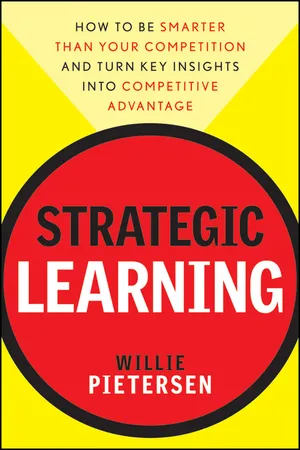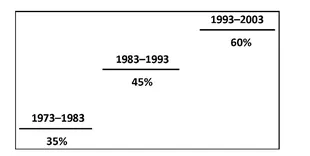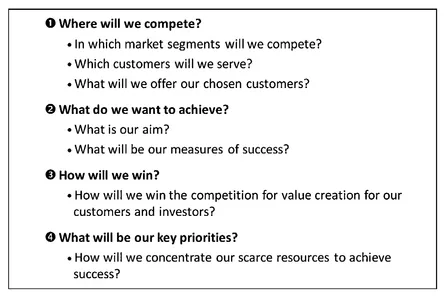![]()
PART I
What Every Organization Needs to Know about Strategy
![]()
CHAPTER 1
The Real Job of Strategy
Our lives are the sum of the choices we make.—Albert Camus
Organizations create their futures through the strategies they pursue. These strategies may be developed in a thoughtful and systematic way or allowed to emerge haphazardly in a series of random, ad hoc decisions made in response to daily pressures. But one way or another, the strategy a company follows—that is, the choices it makes—determines its likely success. And in today’s fast-changing environment, the ability to generate winning strategies, develop the tools to apply them, and mobilize employee commitment—not once but repeatedly—is more important than ever.
Yet astonishingly few executives, let alone the rank and file, are able to explain their company’s strategy in a clear and compelling way. The trouble is that strategy is a largely misunderstood and misapplied concept. Somehow, there’s a notion that strategy is complex and mysterious, something best left to gurus and experts. Actually, the opposite is true. It’s not at all arcane. In fact, it’s dead simple, and therein lies its power.
It’s puzzling that so few companies have devoted sufficient time or energy to clarifying the nature of strategy or to creating an effective, organization-wide method for developing winning strategies. Instead, many of them plunge directly into strategy formulation on impulse, without defining a clear process. It’s as if the manager of an auto assembly plant were to dump a load of parts onto the factory floor and tell the workers, “Here, make some cars,” without defining a manufacturing process with the end product in mind.
The penalties for this lack of strategic leadership are considerable. A survey of 336 organizations by Right Management Consultants found that two-thirds of employees do not know or understand their company’s strategy.
1 A poll of 23,000 employees highlighted by Stephen Covey paints a similarly disturbing picture:
2 • Only 37 percent said they have a clear understanding of what their organization is trying to achieve, and why.
• Only 20 percent were enthusiastic about their team’s and their organization’s goals.
• Only 20 percent said they had a clear “line of sight” between their tasks and their organization’s goals.
It is hard to imagine how such companies can hope to survive and thrive with this lack of clarity and employee alignment on strategic direction. In fact, the evidence shows that the ability of organizations to maintain success in our VUCA (volatile, uncertain, complex and ambiguous) environment is inexorably declining. A survey of Fortune 1000 companies since 1973 found that between 1973 and 1983, 35 percent of the top 20 names were new (see Figure 1.1). The number rose to 45 percent in the following decade, and between 1993 and 2003, shot up to 60 percent.3
This state of affairs suggests that one of the highest hurdles facing organizational leaders today is their inability to mobilize their companies behind strategies that create and sustain competitive advantage.
Figure 1.1 Fortune 1000 Companies: Percent New in Top 20
Source: Edward E. Lawler III and Chris Worley, Built to Change: How to Achieve Sustained Organizational Effectiveness (Jossey-Bass, 2006).
The primary aim of this book is to offer a practical and proven method for creating and implementing winning strategies, and renewing those strategies as the environment changes. But this process—Strategic Learning—is not just a step-by-step ritual. It is inspired by a set of crucial underlying ideas. The key to the successful application of Strategic Learning is to understand and mobilize these key concepts.
To clarify our thinking, we need to answer two important questions:
• What is strategy?
• What key questions must strategy answer for us?
Let’s examine each of these questions.
What Is Strategy?
Aristotle said, “We do not know a truth without knowing its cause.” Following Aristotle’s logic, the best way to understand the real meaning of strategy is to understand its origins. Where does it come from? Why does it exist? What is so compelling about it?
What gave birth to strategy was the need to respond to two inescapable realities: the fact that we have limited resources, and the inevitability of competition. These stark realities force organizations to make choices on how best to use their scarce resources for the achievement of competitive advantage. The purpose of this choice-making is to create an intense focus on the few things that matter most to an organization’s success.
Strategy is, simply, the sum of an organization’s choices about where it will compete, how it will create superior value for its customers, and how it will generate superior returns to its investors. In a world of limited resources, a company that tries to be all things to all people, with no specific focus or direction, will soon squander its resources and either fall behind its competitors or go out of business.
Consider this: If you had unlimited resources, there would be no requirement for a strategy because there would be no need to decide what not to do. You could eliminate all risk by endlessly piling on resources, just in case your choices were wrong. You could survive indefinitely by throwing time and money and people at your problems until your obstacles and competitors are utterly overwhelmed. But in the real world, there is no such thing as unlimited resources. Even the world’s greatest corporations have only so much cash, so many employees, so many factories.
The way that competition expresses itself is through the interaction of choices in the marketplace. The smartest choices, well executed, will win the game.
What Key Questions Must Strategy Answer for Us?
What do the key deliverables of strategy look like? If it is to create value, strategy must provide a good return on the time and effort we put into it.
A successful strategy is not just a matter of open-ended choice-making. It is choice-making in service of answering some specific and very important questions. The answers to these questions will determine your destiny.
To clarify what these questions are and why they are important, let’s go back for a moment to the origins of strategy. Strategy was originally a military concept. The word is derived from the Greek strategia, meaning “generalship,” which itself is compounded from two words, stratos, meaning “army,” and agein, “to lead.” (Note the implicit connection between strategy and leadership, a theme to which I’ll return throughout this book.)
Now let’s indulge in a little military role-playing.
Imagine that you are the leader of a country—let’s call it country A. Assume that for good and sound reasons, country A is faced with the unpleasant prospect of going to war against country B. You have asked your experts to study and compare the resources available to your country and country B. There are disparities, relative strengths and weaknesses, that call for a really smart approach to conducting this war.
Faced with this challenge, you call a cabinet meeting and ask your most senior general to be in attendance. You discuss the relative resources available to your country and country B. The general assures you that he has done his homework on this. Now you ask the big question that every good general must be able to answer: “General, how will we win?”
But if he is a good general, he will refuse to answer your question, until you have provided a clear answer to his question: “What is your aim?” What do you want to achieve by going to war? Is it regime change? Is it disarmament? Is it nation-building? The point is, you can’t figure out how you will win until you define what kind of contest you are involved in.
Let’s translate this role-play into a business context. Of course, there are differences between warfare and business strategy. War is a matter of life and death, and wars are typically zero-sum encounters. But this military example clarifies some key principles about any kind of strategy.
The first and most crucial point is that a strategy must define how you will win. This concept is not exclusive to warfare. On this point we must be clear: Winning in business means winning at value. That is a central theme of this book.
Figure 1.2 The Key Questions Strategy Must Answer
Second, the military role-play clarifies the questions that must be asked in the process of strategic choice-making for any enterprise. It is the answers to these questions that make your strategy specific, clear, and actionable.
Here, then, in Figure 1.2, are the key questions every organization must answer in the process of creating a strategy.
Military analyst Antoine Jomini writes that strategy is the concentration of mass upon decisive points. It’s the same in business. Answering these questions forces an enterprise to make its critical strategic choices and thereby harness the power of concentration. The ultimate purpose of a strategy is to create clarity of focus. This, in turn, is the essential platform for leadership effectiveness.
Choice-Making in Action
The contest playing out between Boeing and Airbus in the commercial aviation business provides a dramatic example of how each company has dealt with the challenges of high-stakes choice-making.
Boeing and Airbus manufacture aircraft for commercial carriers such as Continental Airlines, United, Singapore Airlines, and others. They compete against each other in the same key markets and with a similar portfolio of planes. Measured by size, range, fuel efficiency, and operational reliability, for example, there is not a major difference between a Boeing 737 and an Airbus A320. As the new millennium dawned, each company looked for a development that would conclusively give it a competitive advantage.
Boeing had actually captured such an advantage decades before, when it introduced the large, more comfortable, 747. The Concorde, although a financial disaster, was another plane that clearly changed the flying experience for passengers, persuading an affluent group of people to choose British Airways or Air France just to enjoy the benefits of this supersonic plane.
Now, both Airbus and Boeing were determined to develop an operationally efficient, more passenger-pleasing aircraft that would have the same disruptive qualities as the Concorde. Boeing actually called this futuristic plane “the game changer.”
The crucial question each company faced was, in a game of bet and counterbet, which particular choice would eclipse the other player? Should it be a large-capacity plane best suited to the hub-and-spoke market, like an updated 747? Or should it aim its new entry mainly at the point-to point routes that avoid connecting between busy airport hubs? Which segment was likely to have the most growth in the future, and what kind of plane would create the greatest value for the airlines and their customers in that segment? Of course, these alternatives have certain elements in common, but in terms of their core benefits they are different, and therefore so is their likely growth potential.
Boeing has placed its bet on the point-to-point market. Its new entry will be the 787, designed to carry about 250 passengers, which it has dubbed the Dreamliner. With a new generation of fuel-efficient engines and a skin made largely from carbon-reinforced plastic, the plane represents an exciting technological breakthrough. Carbonfiber composites such as this routinely strengthen tennis rackets and parts of fighter planes, but had never been used on such a large scale. The 787’s transformational technology enhances the customer experience with improved air quality inside the cabin, and bigger windows, as well as, according to Boeing, making the plane 20 percent less expensive to operate and a third less expensive to maintain than its competitive equivalents. The list price is stated to be about $150 million per plane.
Airbus, meanwhile, placed its bet on the hub-and-spoke market with the huge A380. Carrying approximatel...


